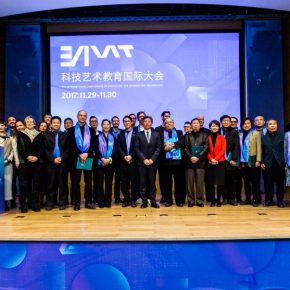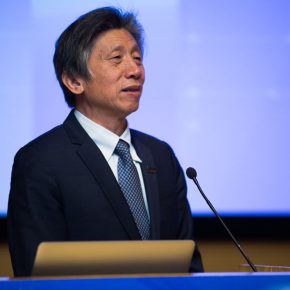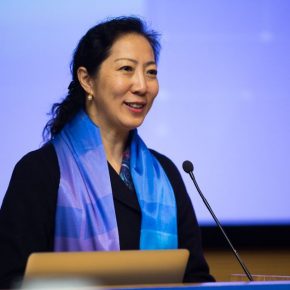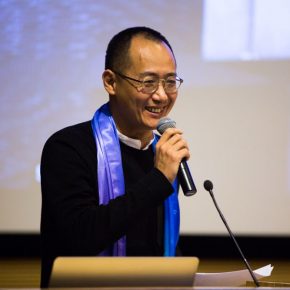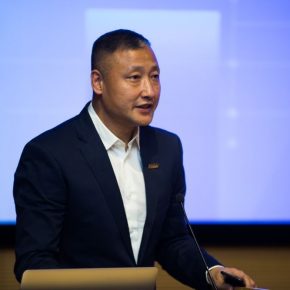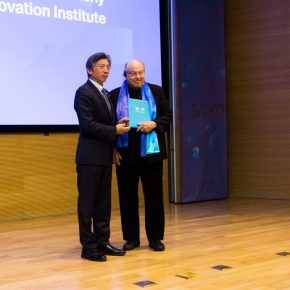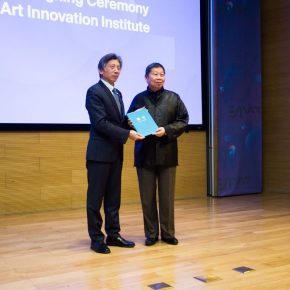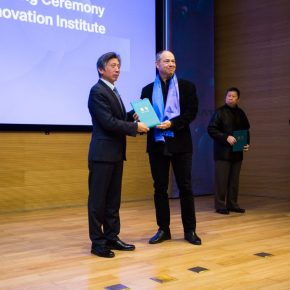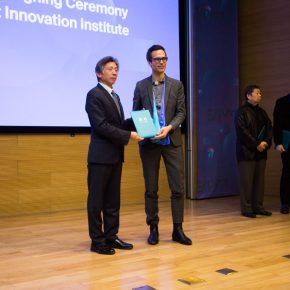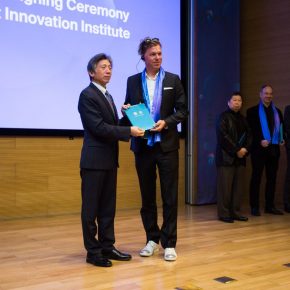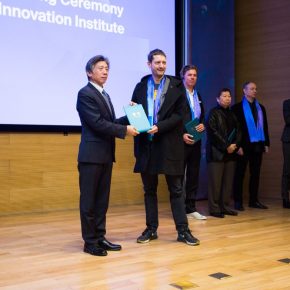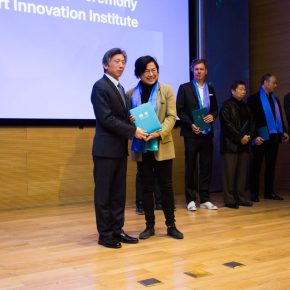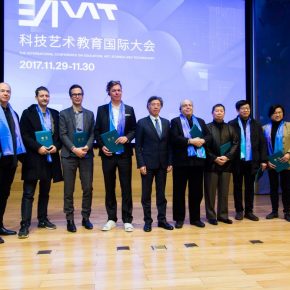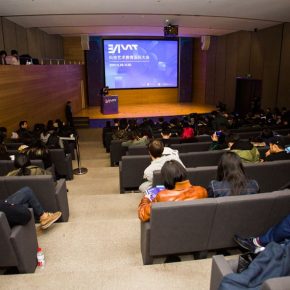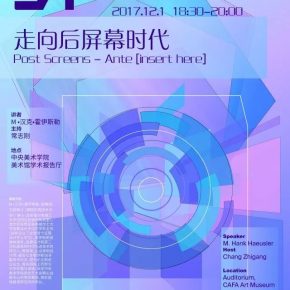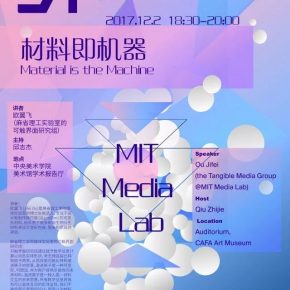
On November 29, 2017, hosted by CAFA, and organized by CAFA Visual Art Innovation Institute, the first EAST (Education, Art, Science, and Technology) Season: EAST–International Conference on Education, Art, Science and Technology was held in a grand fashion at CAFA. The two-day conference invited internationally renowned scholars to deliver speeches and hold in depth communication sessions. The topics spanned from the narration of the history and future of the science & technology and art, to the scientific subdivision including the biological art and material art, from academic cases to exhibitions and publications, it brought a feast for the imagination and creativity, while clearly analyzing the status quo and drawing a panorama of the new fields.
Fan Di’an, President of CAFA, Wang Shaojun, Deputy Party Secretary of CAFA, Wang Xiaolin, President Assistant of CAFA & Director of CAFA Visual Art Innovation Institute, W. John Kao, Vice President of the University of Hong Kong, Roy Ascott, Plymouth University, UK, Eduardo Kac, the School of the Art, Institute of Chicago (SAIC), US, Eleanor Dare, Royal College of Art, UK, Sven Travis, Parsons School of Design, US, Richard Allen, City University of Hong Kong, Shona Kitchen, Rhode Island School of Design (RISD), US, Jun-Jieh Wang, Taipei National University of the Arts, Ken Rinaldo, The Ohio State University, US, Janis Jefferies, Goldsmiths, UK, Edward Shanken, University California, Santa Cruz, US, Beryl Graham, CRUMB, University of Sunderland, UK, Dillion Zhang, Founder, Media Art Strategist, China, Anett Holzheid, ZKM, Germany, Michel van Dartel, V2, Netherlands, Ionat Zurr, SymbioticA, Australia, Manuelle Freire, Concordia University, Canada, Wang Chuan, Director of Developing and Planning Section, CAFA & Vice Director of CAFA Visual Art Innovation Institute, Qiu Zhijie, Dean, School of Experimental Art, CAFA, Chen Xiaowen, Professor, School of Art and Design, Alfred University, US and Guest Professor, CAFA, Zhang Zikang, Director of CAFA Art Museum, and Lv Pinjing, Dean, School of Architecture, CAFA, all attended the opening ceremony. The opening ceremony was hosted by Chang Zhigang, Executive Vice Director of CAFA Visual Art Innovation Institute.
Fan Di’an, President of CAFA addressed the opening ceremony and said that, EAST (Education, Art, Science, and Technology) Season and the International Conference on Education, Art, Science and Technology was held at CAFA, which was a milestone in the history of CAFA, and a new starting point for the integration and innovation of science & technology and art for the education of higher art in China. The development of global science & technology and the exchange of the information era were changing people’s lifestyle and social cultural patterns, offering opportunities and challenges for artistic creation. As an art education institution, it was necessary to establish a platform for mutual integration and mutual stimulation for science & technology and art, so that the younger generation could stand on a new starting point of knowledge innovation and artistic creativity, in addition to the traditional classrooms of professional knowledge. CAFA would regard the education of science & technology and art as one of the most important strategies for its future development. EAST strategy aimed at introducing scientific thinking and technological innovation into art education, stimulating new imagination by new thinking, transforming new technologies into new languages, to develop a new form of art and create new artistic achievements, on the other hand, through the combination of science & technology and art to offer society new application products, promoting social innovation. China was accelerating the building of an innovative nation. From the government to the ordinary people, from academic institutions to enterprises, innovation has become a consensus that it needed to cultivate innovative talents in the art school, through the study, research and production to change in our lives through artistic creativity. Located in Beijing, CAFA had a bigger responsibility of offering its artistic intellectual support to the comprehensive development of Beijing, through the interdisciplinary combination of science & technology and art to promote Chinese economic development, in the context of the economic development that has changed and cultural industry was booming in China.
Wang Xiaolin, President Assistant of CAFA & Director of CAFA Visual Art Innovation Institute addressed the opening ceremony and introduced the basic situation of the Visual Art Innovation Institute. In 2015, the CAFA Visual Art Innovation Institute was among the first group of institutions selected for the Beijing Advanced Innovation Center Program. It was also the only art college selected among 13 colleges and universities. The Institute adopts an innovative “interdisciplinary, cross-disciplinarity” mechanism, whereby this platform enables the removal of existing bottlenecks of scientific research and teaching to pursue the interlinking of “research, learning, and production” that is forward-looking and in line with the development of the times. In this way, it can build a collaborative innovation model that is oriented towards achieving a fourfold synergy between the scientific frontier, cultural heritage innovation, industry, and major regional developmental needs, thus building two “1 + 4” models. The first goal is to create a “visual culture system” for Beijing, enhance the visual image of the city and incorporate the city’s cultural developmental strategy. The second goal is to bring in internationally-renowned masters with “Visual Beijing” as a blueprint, driving the “research, learning, and production” development of Beijing’s related professional colleges and universities. In terms of content, “Spatial Beijing”, “Visual Beijing”, “Fashion in Beijing”, and “Life in Beijing” will be the main four components of the event. In terms of organization and structure, CAFA will lead and build a platform for “research, learning, and production”, enabling the achievement of resource sharing between four of Beijing’s colleges and universities, namely Beijing University of Technology, Beijing University of Civil Engineering and Architecture, Beijing Film Academy, and Beijing Institute of Fashion Technology.
Qiu Zhijie, Dean, School of Experimental Art, CAFA, addressed the opening ceremony, and briefly introduced the EAST Season of the year, and said that, “When people over-exaggerate in describing how the advances in science & technology unexpectedly arrive in the world, we have forgotten about the technological progresses took place long time ago, including the use of fire or metal smelting, including the wheel or printing, they also surprised people at that time. Nowadays, the development of contemporary art itself has gone far beyond the visual field; the development of science & technology goes far beyond the image-centric field. In addition to big data and artificial intelligence, profound changes are taking place in a wide range of areas such as biotechnology, nanotechnology, new energy and new materials, while it is the time for the artists to transcend the screen, going to a broader world of science and technology. The EAST Season demands to complete an iteration and expansion of media art, new media art, digital art and electronic art through the concept of the science & technology and art. Science & technology and humanities have never been separated in history. It is the time to propose that the perfect intelligence, including artificial intelligence, must embody compassion and morality. An important mission of this conference lies in building a platform for deep integration and active cooperation among art theorists, artists, art institutions, and innovative enterprises. Driven by the collective will of the community, science and technology is becoming a practical requirement, and the conditions for the large-scale outbreak of science & technology are ripe. The needs of science & technology are determined by the Chinese airports, high-speed rail stations, scenic spots, public squares, art museums, and commercial exhibition spaces. Technological innovation and artistic innovation, as well as the integration of technology and art, are in need of the support of institutional innovation. EAST’s mission is to set up a shared platform that brings together all forces and creates a global alliance of art and technology institutions, research centers and other educational entities.”
At the end of the opening ceremony, Fan Di’an, President of CAFA, presented a letter of appointment to each distinguished expert of the CAFA Visual Art Innovation Institute.
The two-day conference also includes the EAST–Enterprise Innovation Forum, which took place on November 30. It brought together elite groups in various fields such as art, scientific research, industry and venture capital, to hold discussions on the topics including the experience and prospect of the cooperation between enterprises and research centers & art institutions, and those devoted to building a platform for the deep integration of the science & technology and art and the enterprise development.
Text by CAFA Visual Art Innovation Institute, translated by Chen Peihua and edited by Sue/CAFA ART INFO
Photo by Yang Yanyuan from CAFA ART INFO


